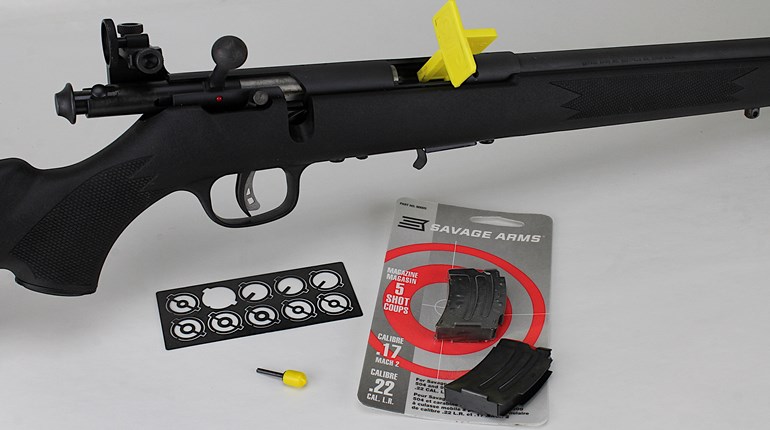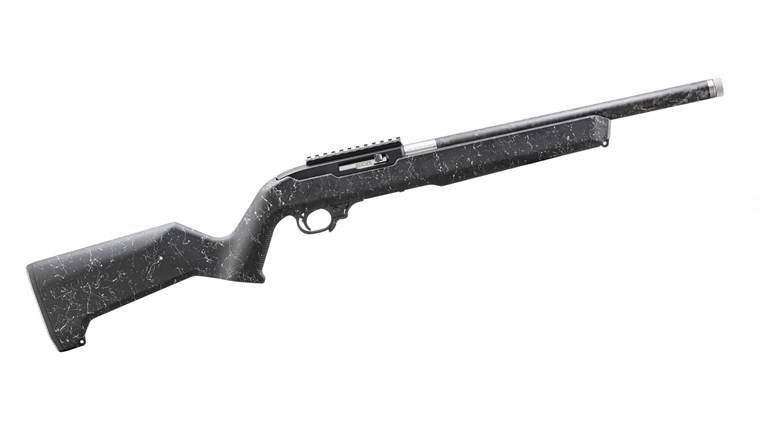
Winchester and Africa have been together for as long as hunters have gone on safari. I don't exaggerate-Winchester was along on literally the first safari in the modern era. It was also present during the grandest of all safaris, President Theodore Roosevelt's 1909 year-long hunting expedition to East Africa. In fact, Teddy took five crates of Winchesters, including his "lion medicine," a model 1895 in .405 Winchester.
However, the 1895 is not the Winchester rifle that has become so highly regarded for hunting Africa's dangerous game. That honor goes to the Model 70—Winchester's iconic bolt-action introduced in 1936. More than anything else, the Model 70 made its name in Africa with the .458 Win. Mag., a cartridge specifically designed to equal the performance of the best-selling double-rifle caliber of the day, the .470 Nitro Express.
Winchester touted the Model 70 in .458 Win. Mag. as an ideal dangerous-game rifle via an advertising campaign featuring "Our Man In Africa" in which professional hunter David Ommanney extolled its virtues. It retailed for $154.95 in the 1964 ad.
Today's Model 70 Safari Express rifle has evolved considerably since then. Without delving into the Model 70's storied history, the rifle has undergone a number of transformations, some better forgotten, others much for the good, leading to today's current production rifle. Despite a widely held sentimental worship of the "pre-'64" version, I have no qualms in saying the current Model 70 made by FN in South Carolina is the best Model 70 ever produced.
FN picked up the Winchester ball after the historic gunmaker's factory in Connecticut was shut down several years ago. The Model 70 had already undergone a major refurbishment as the Classic Model 70 with a return to the controlled-round feeding and claw extractor of the "pre-'64" version. At the same time, the rifle's over-pressure safety system, a means to vent gas away from the shooter in the event of a catastrophic ammunition failure, was greatly improved. The bolt's travel in the action's raceway was smoothed with a better anti-bind feature.
FN took this upgraded Model 70 and improved it even more with an entirely new trigger system known as the MOA trigger. It uses a leverage system to effectively reduce the "feel" of the pressure required to press the trigger by one-half. A 4-pound trigger feels like a 2-pound trigger-a stupendous advance in the Model 70.
The trigger is the single-most important physical component of accurate shooting. Granted, 90 percent of being a good shot is mental, your ability to concentrate and control your neurological impulses that constrict the small muscles of the trigger finger. Your brain-box controls whether you evenly compress the trigger and don't jam it, jerk it, flinch it or slap it.
That said, a light trigger is a more controllable trigger. Without exception, every NRA Bullseye shooter attends to his rifle's trigger. Some are mere ounces, when allowed by rule, but that's going too far on a hunting rifle (unless it's a "set" trigger, which is totally different). The point is the new Model 70 has an utterly superb trigger and that alone makes me love this rifle.
Additionally, the MOA trigger is creep-free, meaning that there's zero "take-up" when you engage the trigger, no "slack" or "free movement." You immediately feel contact with the sear. Likewise, the MOA trigger has all "over-travel" removed, the free movement of the trigger after it's released the sear.
Another plus for the new Model 70 Safari Express is that it retains the legendary three-position safety that perhaps more than any other single attribute has made the "Rifleman's Rifle" such an iconic design. A small lever protrudes from the rifle's right side, as ergonomically perfect as a safety can be (except for a tang safety). To the rear, the rifle is on safe with the firing pin lifted away from the sear. It's as safe as gold in a recession. The bolt cannot be lifted in the "safe" position to prevent the rifle from falling inadvertently out of battery. The middle position is the "unload safely" mode, in which the firing pin is still out of the way of the sear, but the bolt handle can be lifted to remove a round from the chamber. All the way forward and the rifle is ready to fire.
The Model 70's safety, as excellent as it may be, is often misunderstood, so let me just digress for a moment to make sure we're all clear on the middle position. Some shooters mistakenly think the middle position is a sort of midway point between safe and fire, so if they anticipate a shooting opportunity, they move the safety to the middle position on the theory that it'll be quicker to fire. Wrong! Don't do this! Here's why: When the safety is in the middle position the bolt handle can be lifted, and if it's lifted even a tiny amount, the rifle can't be fired.
I know of a person who was badly gored by a wounded Cape buffalo that in classic fashion had retreated into a thick bush and waited in ambush. As the hunters followed the spoor, the buffalo came like a black torpedo. The hunter swung his rifle up and ... nothing. The PH fired, but the shot failed to stop the enraged bovine before it slammed into the hunter. The hunter was gored through the buttocks, the horn coming out his inner thigh. The PH killed the bull as it ravaged the hunter, whereupon it fell dead, all 1,200 pounds of it, on top of the hunter.
Why didn't the hunter's rifle fire? It was a Model 70 and while I wasn't there to examine it, the hunter said, "I know I put the safety off." Well, I know what happened.
As for fit and finish, the FN-produced Model 70 Safari Express is as good as any Super Grade I've seen from the U.S. Repeating Arms factory. The metal is nicely subdued with a matte blued finish. One nice difference is a much better rear sight (i.e., easier to pick up and seemingly more solidly affixed). As a proper express rifle should be, the front sight is hooded and there's a barrel band sling swivel.
I fitted the test rifle with an Aimpoint Hunter Series sight and took the Safari Express chambered in .458 Win. Mag. to Mozambique to hunt Cape buffalo. The larger Hunter model features a 34mm tube but like all Aimpoint sights, there is no magnification. My accuracy testing before the safari was limited to one brand of ammunition, Winchester Supreme with a 500-grain Nosler Partition bullet. It shot great groups, and with magnification it will shoot minute of angle.
On the Zambezi floodplain, I killed a hard-bossed bull with the Safari Express, with one shot to the heart. Winchester and Africa have enjoyed a long and cozy relationship, and it's still going strong.
Type: bolt-action centerfire rifle
Caliber: .375 H&H Mag., .416 Rem. Mag., .458 Win. Mag. (tested)
Trigger: MOA trigger, 33/4 lbs. pull weight
Magazine: hinged floorplate; 3 rounds cap.
Sights: front, hooded gold bead; rear, V-notch, adjustable
Safety: three-position wing-style
Stock: walnut; dual recoil lugs; dual stock cross-bolts; Pachmayr Decelerator recoil pad
Metal Finish: matte blue
MSRP: $1,349.99




































